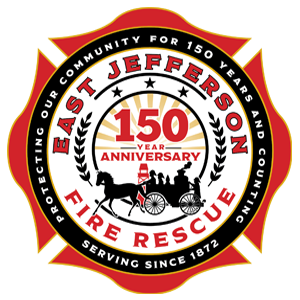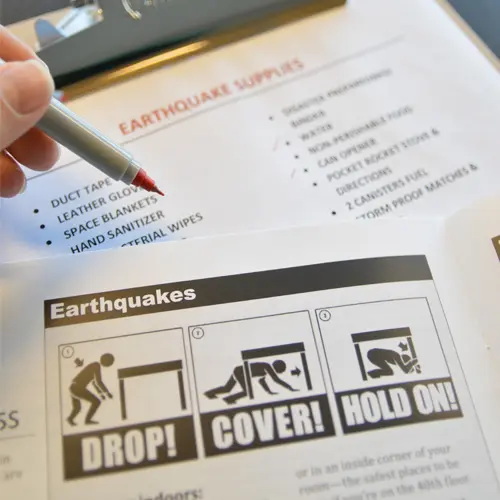Learning How to Survive Earthquakes – Practice Drop, Cover, and Hold!
Protect Yourself During An Earthquake
- If you’re in a HIGH-RISE BUILDING, and you are not near a desk or table, move against an interior wall, and protect your head with your arms. Do not use the elevators.
- If you’re OUTDOORS, move to a clear area, away from trees, signs, buildings, or downed electrical wires and poles.
- If you’re on a SIDEWALK NEAR BUILDINGS, duck into a doorway to protect yourself from falling bricks, glass, plaster, and other debris.
- If you’re DRIVING, pull over to the side of the road and stop. Avoid overpasses, power lines, and other hazards. Stay inside the vehicle until the shaking is over.
- If you’re in a CROWDED STORE, do not rush for exits. Move away from display shelves containing objects that could fall.
- If you’re in a WHEELCHAIR, stay in it. Move to cover, if possible, lock your wheels, and protect your head with your arms.
- If you’re in the KITCHEN, move away from the refrigerator, stove, and overhead cupboards.
- If you’re in a STADIUM or THEATER, stay in your seat and protect your head with your arms. Do not try to leave until the shaking is over. Then leave in a calm, orderly manner.
- Be prepared for AFTERSHOCKS, and plan where you will take cover when they occur. Aftershocks can occur in the first hours, days, weeks, or even months after the quake. Be prepared to take cover.
Full list of Earthquake preparation and safety tips available for download.
Tsunami Safety Information
Port Townsend Tsunami Evacuation Route Map
Port Townsend Inundation Map (Department of Natural Resources)
Point Hudson “All Hazards Alert Broadcast” (AHAB) unit is one of three AHAB tsunami “sirens” in the Port Townsend area. The first AHAB in Washington State was installed at the Port Townsend Marina in 2003. A unit similar to the Point Hudson siren is located on the beach near the campground at Fort Worden. AHABs can be activated by satellite from the State Emergency Operations Center or by radio from the Jefferson County EOC. There are currently 45 AHAB installations in Washington State.
Emergency Supply List
Build a Kit
A disaster supplies kit is simply a collection of basic items your household may need in the event of an emergency.
Try to assemble your kit well in advance of an emergency. You may have to evacuate at a moment’s notice and take essentials with you. You will probably not have time to search for the supplies you need or shop for them.
You may need to survive on your own after an emergency. This means having your own food, water and other supplies in sufficient quantity to last for at least 72 hours. Local officials and relief workers will be on the scene after a disaster but they cannot reach everyone immediately. You could get help in hours or it might take days. The Jefferson County Department of Emergency Management recommends that everyone prepare to be on their own at home for up to 30 days.
Additionally, basic services such as electricity, gas, water, sewage treatment and telephones may be cut off for days or even a week, or longer. Your supply kit should contain items to help you manage during these outages.
Recommended Supplies to Include in a Basic Kit:
Below, you’ll find a sample emergency supply list from Ready.gov. Please note that this is only a sample list. It’s important for you to go over it carefully and modify it to fit your family’s needs.
Water, food, and clean air are important things to have if an emergency happens. Each family or individual’s kit should be customized to meet specific needs, such as medications and infant formula. It should also be customized to include important family documents.
- Water, one gallon of water per person per day, for drinking and sanitation
- Food, at least a three-day supply of non-perishable food
- Battery-powered radio and a NOAA Weather Radio with tone alert, and extra batteries
- Flashlight and extra batteries
- First Aid kit
- Whistle to signal for help
- Infant formula and diapers, if you have an infant
- Moist towelettes, garbage bags and plastic ties for personal sanitation
- Dust mask or cotton t-shirt, to help filter the air
- Plastic sheeting and duct tape to shelter-in-place
- Wrench or pliers to turn off utilities
- Can opener for food (if kit contains canned food)
- Clothing and Bedding: If you live in a cold weather climate, you must think about warmth. It is possible that the power will be out and you will not have heat. Rethink your clothing and bedding supplies to account for growing children and other family changes. One complete change of warm clothing and shoes per person, including:
- A jacket or coat
- Long pants
- A long sleeve shirt
- Sturdy shoes
- A hat and gloves
- A sleeping bag or warm blanket for each person
Below are some optional items for your family to consider adding to its supply kit. Some of these items, especially those marked with a * can be dangerous, so please have an adult collect these supplies:
- Emergency reference materials such as a first aid book or a print out of the information on www.ready.gov
- Rain gear
- Mess kits, paper cups, plates and plastic utensils
- Cash or traveler’s checks, change
- Paper towels
- Fire Extinguisher
- Tent
- Compass
- Matches in a waterproof container*
- Signal flare*
- Paper, pencil
- Personal hygiene items including feminine supplies
- Disinfectant*
- Household chlorine bleach* : You can use bleach as a disinfectant (dilute nine parts water to one part bleach), or in an emergency you can also use it to treat water. Use 16 drops of regular household liquid bleach per gallon of water. Do not use scented, color safe or bleaches with added cleaners.
- Medicine dropper
- Important Family Documents such as copies of insurance policies, identification and bank account records in a waterproof, portable container
CDC Resources
The Centers for Disease Control and Prevention (“CDC”) website has a wealth of valuable information about preparedness for natural disasters and severe weather. Not all disasters are alike and the geography of your region has a great deal to do with the most likely local disasters.
Below you will find links to CDC information for a variety of disasters and severe weather:

